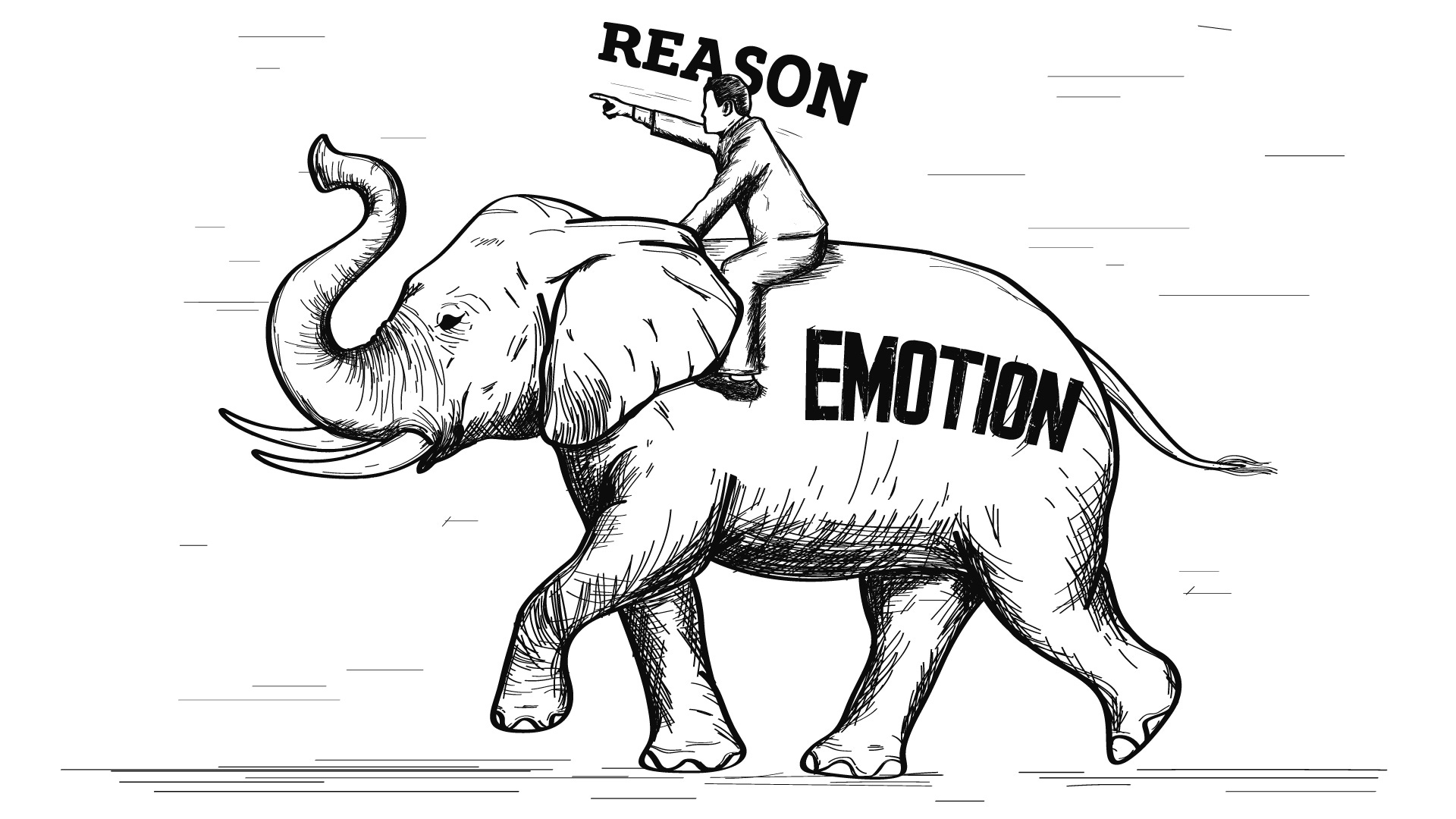Boost your skills with Growth Memo’s weekly expert insights. Subscribe for free!
In There Is No Spoon, I covered Google’s growing emphasis on user satisfaction as key to success in SEO.
The most important key to success with Google Search is to have content that’s meant to please people, rather than to be whatever you might have heard that ‘Google wants.’ For example, people sometimes write content longer than is helpful to their readers because they’ve heard somewhere that ‘Google wants’ long content.
Given that user behavior is fundamental, we need to ask ourselves what drives and influences how people behave.
We pride ourselves on being reasonable apex predators, but the majority of our actions come closer to horny monkeys. Another example is one of a human riding an elephant. The human can give direction but quickly learns who’s really in control when the elephant has an impulse to do something else.
 Image Credit: Lyna ™
Image Credit: Lyna ™The elephant rider example stems from the most comprehensive modern piece of research about online consumer psychology titled “The Messy Middle.”1
The study is from 2020, but it couldn’t be more timely as it gives us a blueprint for what Google is rewriting its SEO guide around impacting user behavior.
What We Missed About The Messy Middle
Researchers at Google partnered with a research agency to figure out how users buy products in 2020. They observed 310,000 purchase journeys across 1,000 people, 31 categories, and 10 simulations.
The conclusion: There is no straight line between trigger and purchase. Instead of a straight line, users oscillate between exploration and evaluation until they find the ideal product. The middle is messy. The findings are critical updates to our operating systems.
Americans spend about 7.5 hours online every day, with one out of three minutes spent on social media.2
Every year, the time goes up, and so does potential exposure to purchase triggers and information for evaluation. We might not realize it, but we constantly float around inspiration and information about products we could or want to buy.
A lot has been written about The Messy Middle, but most articles miss three critical points. The findings suggest:
- Different ways of doing SEO.
- Severe limitations of attribution models.
- The need to merge conversion rate optimization (CRO) and SEO.
Messy Ways Of Thinking About SEO
The Messy Middle is more than a cool new way of saying “funnel.”
We’ve been operating for a long time with the outdated model of linear purchase journeys.
The Messy Middle suggests new ways of thinking about internal linking, content creation, and success metrics that are closer to reality.
For example, internal linking is often built around tops (related articles) or funnel stages (next step).
But since customers loop around exploration and evaluation, we should offer paths to evaluation, exploration and purchase by linking internally to high- and low-intent pages so visitors can choose the next step based on their information gap.
We should build out cornerstone pages with information about the product, reviews, and FAQs, and highlight them in the top nav to make sure users find all the information they need on our site in the evaluation stage.
Instead of TOFU/MOFU/BOFU, we should structure content creation around high- and low-intent topics to simplify information foraging, a concept introduced by The Messy Middle study that reflects the idea of collecting as much information as possible before making a purchase.
The classic mental model is “Our conversion rates are good, so let’s focus on growing the top of the funnel.”
What if we replaced that model with “Let’s focus on providing customers all the information they need to increase the chances they buy our product.“?
The latter means publishing as much information about a product as possible in an accessible way.
For example, many SaaS companies do a poor job of explaining what a product does and how users can use it. They don’t build content around use cases or what they do and how it works.
High intent is often signaled by certain query modifiers, as highlighted in the research:
- “Ideas.”
- “Best.”
- “Difference between.”
- “Cheap.”
- “Deals.”
- “Reviews.”
- “Discount codes,” “deals,” “offer,” “sale.”
Lastly, the idea of category heuristics – numbers customers focus on to simplify decision-making, like megapixels for cameras – offers a path to specify user behavior optimization.
An ecommerce store selling cameras, for example, should optimize its product cards to prioritize category heuristics visually.
Granted, you first need to gain an understanding of the heuristics in your categories, and they might vary based on the product you sell. I guess that’s what it takes to be successful in SEO these days.
Measure The Middle
The Messy Middle varies in length by product and industry, making it hard to generalize. But we can conclude that many of the attribution models and metrics we use are no longer aligned with how people use the internet.
If you’ve ever dealt with revenue attribution at enterprise companies, you know what I’m talking about.
It’s barely possible to measure conversion touchpoints across long time horizons, devices, and channels unless you have a very refined and groomed system – which 99% of companies don’t have. And even if you can measure touchpoints, patterns are hard to see. It’s easy and dangerous to interpret the data based on your own preferences.
The Messy Middle offers a different approach: presence gaps. Instead of trying to figure out where to be, try to be everywhere.
It’s more important to understand where your competitors are, and you’re not since the research found that customers are way more likely to choose alternatives when they have them. The surround sound approach seems intuitive but is a very different approach to what’s happening at companies today.
Surround sound doesn’t mean to do everything, but to carefully observe where competitors are and to pull even. Examples could be review sites, forums, and social platforms. Anything that could trigger a purchase intent or serve during research is fair game.
Depending on your category, price comparison engines, social media platforms, video, news, and niche content such as gaming or technology sites may be equally important when maintaining parity of brand presence.
The Messy Middle touchpoints can be:
Search engines, review sites, video sharing sites, portals, social media, comparison sites, forums, interest groups/clubs, retailer sites, aggregators, blogging sites, voucher/coupon sites, branded sites, publishers, noticeboards.
We should also rethink the numbers we look at.
Recurring visits and the average number of visits until conversion reflect user behavior and improvements better than bounce rate or pages per visit since users hop around so much.
They might view a product on their phones while on the bus, then come home and read reviews on their laptop, and buy through direct visits weeks later when they’re reminded by an out-of-home display ad. Have fun mapping that customer journey.
Tickling Biases
Human biases are subconscious tendencies to make decisions. For example, the elephant might choose a path different from that of the human based on hunger or fear.
Biases can affect whether users:
- Search for our brand.
- Click on our results.
- Stay/return to the site.
- Convert.
In marketing, we love to exploit scarcity. When biases are overexploited, they turn into dark design patterns.
The classic example is a little banner saying, “Only two rooms left at this hotel. Book now to save your room!” But the study shows that scarcity is actually one of the least effective biases.
The Messy Middle introduces six core biases for online purchases, but there are hundreds:
- Social proof: Following the behavior of others, e.g., through ratings and reviews (the most powerful bias by far tested in the study).
- Category heuristics: Evaluating products with a few key metrics, like megapixels for a camera, to simplify the decision (second most powerful bias).
- Authority bias: Shortcut decisions by asking or looking at authorities (especially when buying complex or expensive products).
- Scarcity bias: Time/quantity/access limited.
- Power of now: Wanting things instantly.
- Power of free: People prefer free stuff.
We know that reviews are important for many reasons – one of them being Search Generative Experience (SGE) and AI search engines. But do we leverage them in our copy and be creative enough? Do we provide guidance in content briefs to include social proof, mention category heuristics, and list statements from authorities?
Biases, especially in combination, can be a way to compete with established sites in search. For example, you could beat incumbents by having better reviews, influencers, and fee offers, and by doing a better job of highlighting key evaluation numbers and fast shipping/access.
Reality Check
How well do the numbers we measure reflect user behavior really? I’d argue: not well – and I’ve been guilty of doubling down on numbers myself. But maybe it’s impossible to map customer journeys accurately.
Maybe all we can measure and influence is what we invest in, such as being visible, assisting visitors throughout exploration/evaluation, and monitoring conversions.
We’re more emotional animals and make more decisions from our gut than we like to admit.
We took a few days off last week at the Ritz in Lisbon. In a beautiful playroom, they have a trampoline, an inflatable castle, and little BWM Bobby Cars. Why BMW? Because BMW knows that brand recognition starts as early as 1-2 years of age.
In that vein, RIP to Daniel Kahneman, one of the two inventors of behavioral economics.
1 Decoding Decisions: Making Sense Of The Messy Middle
2 The Time We Spend On Social Media
Featured Image: Paulo Bobita/Search Engine Journal





